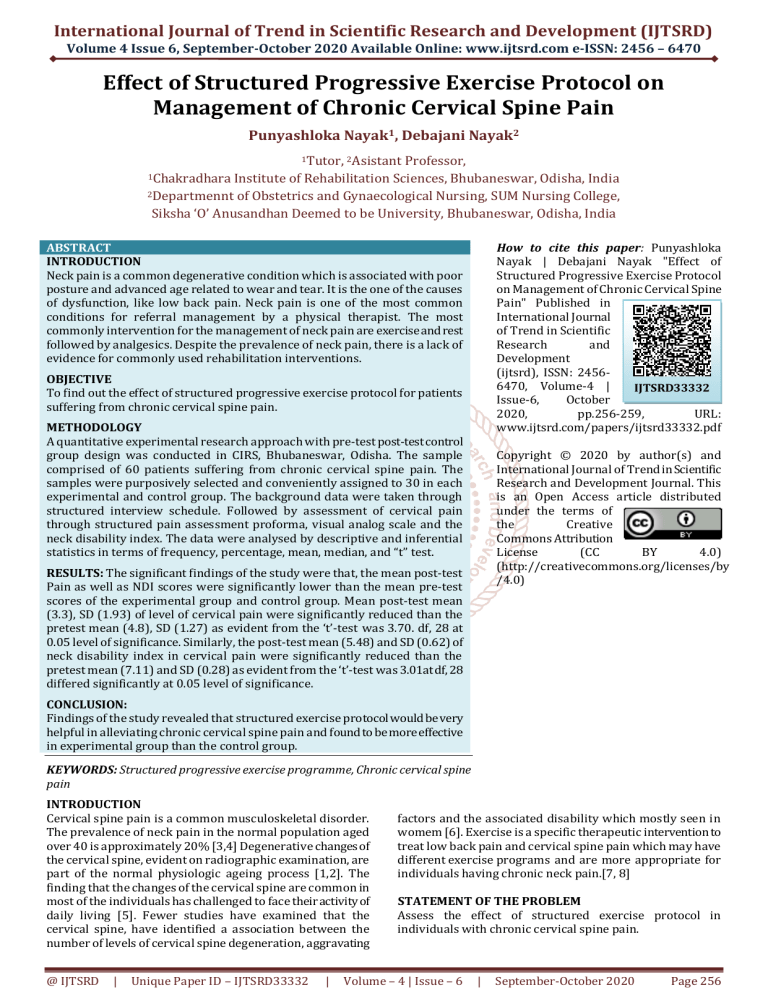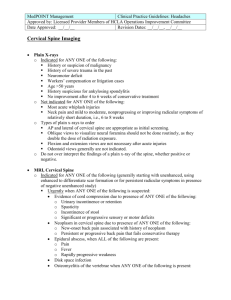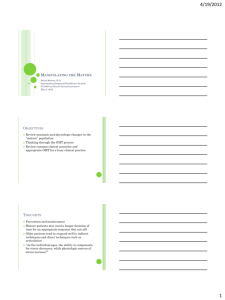
International Journal of Trend in Scientific Research and Development (IJTSRD)
Volume 4 Issue 6, September-October 2020 Available Online: www.ijtsrd.com e-ISSN: 2456 – 6470
Effect of Structured Progressive Exercise Protocol on
Management of Chronic Cervical Spine Pain
Punyashloka Nayak1, Debajani Nayak2
1Tutor, 2Asistant
Professor,
1Chakradhara Institute of Rehabilitation Sciences, Bhubaneswar, Odisha, India
2Departmennt of Obstetrics and Gynaecological Nursing, SUM Nursing College,
Siksha ‘O’ Anusandhan Deemed to be University, Bhubaneswar, Odisha, India
ABSTRACT
INTRODUCTION
Neck pain is a common degenerative condition which is associated with poor
posture and advanced age related to wear and tear. It is the one of the causes
of dysfunction, like low back pain. Neck pain is one of the most common
conditions for referral management by a physical therapist. The most
commonly intervention for the management of neck pain are exercise and rest
followed by analgesics. Despite the prevalence of neck pain, there is a lack of
evidence for commonly used rehabilitation interventions.
How to cite this paper: Punyashloka
Nayak | Debajani Nayak "Effect of
Structured Progressive Exercise Protocol
on Management of Chronic Cervical Spine
Pain" Published in
International Journal
of Trend in Scientific
Research
and
Development
(ijtsrd), ISSN: 24566470, Volume-4 |
IJTSRD33332
Issue-6,
October
2020,
pp.256-259,
URL:
www.ijtsrd.com/papers/ijtsrd33332.pdf
OBJECTIVE
To find out the effect of structured progressive exercise protocol for patients
suffering from chronic cervical spine pain.
METHODOLOGY
A quantitative experimental research approach with pre-test post-test control
group design was conducted in CIRS, Bhubaneswar, Odisha. The sample
comprised of 60 patients suffering from chronic cervical spine pain. The
samples were purposively selected and conveniently assigned to 30 in each
experimental and control group. The background data were taken through
structured interview schedule. Followed by assessment of cervical pain
through structured pain assessment proforma, visual analog scale and the
neck disability index. The data were analysed by descriptive and inferential
statistics in terms of frequency, percentage, mean, median, and “t” test.
Copyright © 2020 by author(s) and
International Journal of Trend in Scientific
Research and Development Journal. This
is an Open Access article distributed
under the terms of
the
Creative
Commons Attribution
License
(CC
BY
4.0)
(http://creativecommons.org/licenses/by
/4.0)
RESULTS: The significant findings of the study were that, the mean post-test
Pain as well as NDI scores were significantly lower than the mean pre-test
scores of the experimental group and control group. Mean post-test mean
(3.3), SD (1.93) of level of cervical pain were significantly reduced than the
pretest mean (4.8), SD (1.27) as evident from the ‘t’-test was 3.70. df, 28 at
0.05 level of significance. Similarly, the post-test mean (5.48) and SD (0.62) of
neck disability index in cervical pain were significantly reduced than the
pretest mean (7.11) and SD (0.28) as evident from the ‘t’-test was 3.01at df, 28
differed significantly at 0.05 level of significance.
CONCLUSION:
Findings of the study revealed that structured exercise protocol would be very
helpful in alleviating chronic cervical spine pain and found to be more effective
in experimental group than the control group.
KEYWORDS: Structured progressive exercise programme, Chronic cervical spine
pain
INTRODUCTION
Cervical spine pain is a common musculoskeletal disorder.
The prevalence of neck pain in the normal population aged
over 40 is approximately 20% [3,4] Degenerative changes of
the cervical spine, evident on radiographic examination, are
part of the normal physiologic ageing process [1,2]. The
finding that the changes of the cervical spine are common in
most of the individuals has challenged to face their activity of
daily living [5]. Fewer studies have examined that the
cervical spine, have identified a association between the
number of levels of cervical spine degeneration, aggravating
@ IJTSRD
|
Unique Paper ID – IJTSRD33332
|
factors and the associated disability which mostly seen in
womem [6]. Exercise is a specific therapeutic intervention to
treat low back pain and cervical spine pain which may have
different exercise programs and are more appropriate for
individuals having chronic neck pain.[7, 8]
STATEMENT OF THE PROBLEM
Assess the effect of structured exercise protocol in
individuals with chronic cervical spine pain.
Volume – 4 | Issue – 6
|
September-October 2020
Page 256
International Journal of Trend in Scientific Research and Development (IJTSRD) @ www.ijtsrd.com eISSN: 2456-6470
OBJECTIVES
1. To assess the level of pain in patients of chronic cervical
spine.
2. To evaluate the effect of structured exercise protocol for
patients suffering from chronic cervical spine pain.
METHODS AND MATERIALS:
A quantitative research approach with pre and post-test
control group design was conducted in CIRS, Bhubaneswar,
Odisha. A total of 60samples were selected through
purposive sampling technique and assigned them randomly
to the groups as 30 in each experiment & control group.
The samples were taken according to their inclusion criteria
like; 20-50 years of individuals having history of neck pain
more than three months, VAS more than 3, NDI > 20%.
Children, having signs and symptoms of neurological
disorders, previous or present of history of trauma with or
without structural disorders in the neck, shoulder and head,
Neoplasm of head and neck, etc were excluded from the
study. To collect the data a structured interview schedule
was taken for demographic data followed by structured
performa for physical assessment. The cervical neck pain
assessment included as type of pain, nature of pain,
aggravating factor, relieving factor, behaviour, irritability,
gait and motion sickness. After that, the neck disability index,
VAS, the self-structured assessment instrument to measure
the rate of disability due to neck pain was taken.
PROCEDURE:
The Structured exercise program was given for 10-12
repetitions for 15 minutes a day for 2 weeks. Supine lying
upper limbs elevated above head to reduce cervical lordosis
through Supine lying pressing against plinth, Chin tucks in
Experimental Group
supine lying, Chin tuck and neck flexion in supine lying, Neck
flexion to look at toes. The Extension exercises-prone lying
done through Looking in front prone lying without chin lift,
looking up with chin lift, Neck extension without forearm
support, Neck extension with forearm support, Right upper
limb followed by left upper limb stretched in front with neck
extension & rotation to right, finally both the upper limbs
stretched out with extension of neck.
RESULT AND DISCUSSION
Most of the samples (60%) of the experiment group whereas
(40%) of the control group were 31-40years of
age.62%Samples in the experimental and 58% in the control
group were males and rest of were females. In religion many
of the subjects 76% of the test group were Hindus. As regard
to education more numbers 64% of the treatment group
were having graduate whereas only 40% of the control
group were having postgraduates. Majority of the samples
56.3% in experimental group 60% in control group
werelabourer.
The data depicted in figure- 1 shows that; As regard to typeof
pain 27%of the treatment group were having stabbing &
sharp pain whereas 40% of the control group were having
only sharp pain. In nature of pain all the samples of both the
groups were having presence of chronic cervical pain.
Further it shows 27% of experimental group-I and 33% of
control group were having prolonged bending as an
aggravating factor. Similarly, the reliving factors of pain
shows 27% of experimental group were by raising & as day
progress whereas27% of control group were by lying
position. All the samples of both the groups were having
normal gait and no motion sickness were present.
Control Group
Figure-1: Types of pain found in chronic cervical spine pain in experimental and control group.
@ IJTSRD
|
Unique Paper ID – IJTSRD33332
|
Volume – 4 | Issue – 6
|
September-October 2020
Page 257
International Journal of Trend in Scientific Research and Development (IJTSRD) @ www.ijtsrd.com eISSN: 2456-6470
Table-1: Mean, Standard Deviation & ‘t’ test of pre-test & post level of cervical spine pain among experimental and
control group
N = 60
Experimental group(n = 30)
Level of cervical spine pain
Mean
SD
Pre-test
4.8
1.27
Post test
3.3
1.93
Control group (n = 30)
‘t’ test
3.70*
Mean
SD
5.5
1.71
5.2
1.64
‘t’ test
0.81NS
α ≤ 0.05 level of significance
Table- 1 shows that, In Experimental group, the post-test mean (3.3), SD (1.93) of level of cervical pain were significantly
reduced than the pretest mean (4.8), SD (1.27) as evident from the ‘t’-test was 3.70. Which was a true difference and not by
chance. Where as in control group in post-test means (5.2) and SD (1.64) of level of cervical pain were significantly not reduced
than the pre-test mean (5.5) and SD (1.71) as evident from the ‘t’ value was 3.70 at df 29 in less than 0.05 level of significance.
So, it was inferring that the level of cervical pain was reduced in treatment group than the control group after receiving
structured exercise protocol.
Table-2: Mean, Standard Deviation & ‘t’ test of pre-test & post Neck Disability Index among experimental and
control group
N = 60
Neck Disability Index
Experimental group (n = 30)
Mean
SD
Pre-test
7.11
0.28
Post test
5.48
0.62
‘t’ test
Control group (n = 30)
Mean
SD
6.48
0.28
6.30
0.24
3.01*
‘t’ test
1.48NS
α ≤ 0.05 level of significance
Table- 2, shows that, In Experimental group, the post-test mean (5.48) and SD (0.62) of neck disability index in cervical pain
were significantly reduced than the pretest mean (7.11) and SD (0.28) as evident from the ‘t’-test was 3.01. Which was a true
difference and not by chance. Where as in control group in post-test means (6.30) and SD (0.24) of neck disability index of
cervical pain were significantly not reduced than the pre-test mean (6.48) and SD (0.28) as evident from the ‘t’ value was 1.48
at df 29 in less than 0.05 level of significance. So, it was inferring that the neck disability index of cervical pain was reduced in
treatment group than the control group after receiving structured exercise protocol.
Table -3: Association between the level of cervical pain with selected demographic variables
N = 60
CHI SQUARE
LEVEL OF
SL NO
DEMOGRAPHIC VARIABLES
Df
P value
VALUE (X2)
SIGNIFICANCE
1
Age
3
7.80
0.04
Significant
2
Gender
1
7.79
0.04
Significant
3
Occupation
3
3.19
0.05
Significant
4
Presence of number of aggravating factors
3
5.79
0.05
Significant
5
Duration of experience of pain
2
7.62
0.04
Significant
The table-3, reveals that the association between level of cervical pain and selected demographic variable of the samples
revealed that there was significant association (p≤0.05) as evident from the chi value with variables such as Age, Gender,
Occupation, Presence of number of aggravating factors, Presence of number of aggravating factors and duration of experience
of pain.
ETHICAL CONSIDERATION
Purposes of the study were explained to the samples,
consent taken and confidentiality was assured. Permission
obtained from the Head of the Department. No problem was
faced during the data collection period. There was full cooperation from the sample, staff, and administration.
@ IJTSRD
|
Unique Paper ID – IJTSRD33332
|
CONCLUSION
On the basis of the findings, crinic cervical spine pain having
significantly differ in VAS scores and NID scores as observed
in pre and post-therapy with the control group. Further it
also shows that structured exercise protocol was
significantly reduced perception of individuals in chronic
Volume – 4 | Issue – 6
|
September-October 2020
Page 258
International Journal of Trend in Scientific Research and Development (IJTSRD) @ www.ijtsrd.com eISSN: 2456-6470
cervical spine pain. So it was concluded that the exercise was
effective at reducing pain and increasing function compared
with usual care.
REFERENCE:
[1] Gore DR (2001) Roentgenographic findings in the
cervical spine in asymptomatic persons: a ten-year
follow-up. Spine 26(22):2463–2466
[2] Gore DR, Sepic SB, Gardner GM (1986)
Roentgenographic findings of the cervical spine in
asymptomatic people. Spine 11(6):521–524
[3] Bovim G, Schrader H, Sand T (1994) Neck pain in the
general population. Spine 19(12):1307–1309
[4] Brattberg G, Thorslund M, Wikman A (1989) the
prevalence of pain in a general population. The results
of a postal survey in a county of Sweden. Pain
37(2):215–222
@ IJTSRD
|
Unique Paper ID – IJTSRD33332
|
[5] Boden SD, McCowin PR, Davis DO, Dina TS, Mark AS,
Wiesel S (1990) Abnormal magnetic-resonance scans
of the cervical spine in asymptomatic subjects. A
prospective investigation. J Bone Joint Surg Am
72(8):1178–1184
[6] Marchiori DM, Henderson CN (1996) A cross-sectional
study correlating cervical radiographic degenerative
findings to pain and disability. Spine 21(23):2747–
2751
[7] Dagenais S, Caro J, Haldeman S.( 2008) A systematic
review of low back pain cost of illness studies in the
United States and internationally. Spine J; 8:8–20.
[8] 2. van Middelkoop M, Rubinstein SM, Verhagen AP, et
al. (2010) Exercise therapy for chronic nonspecific lowback pain. Best Pract Res Clin Rheumatol; 24:193–204.
Volume – 4 | Issue – 6
|
September-October 2020
Page 259





